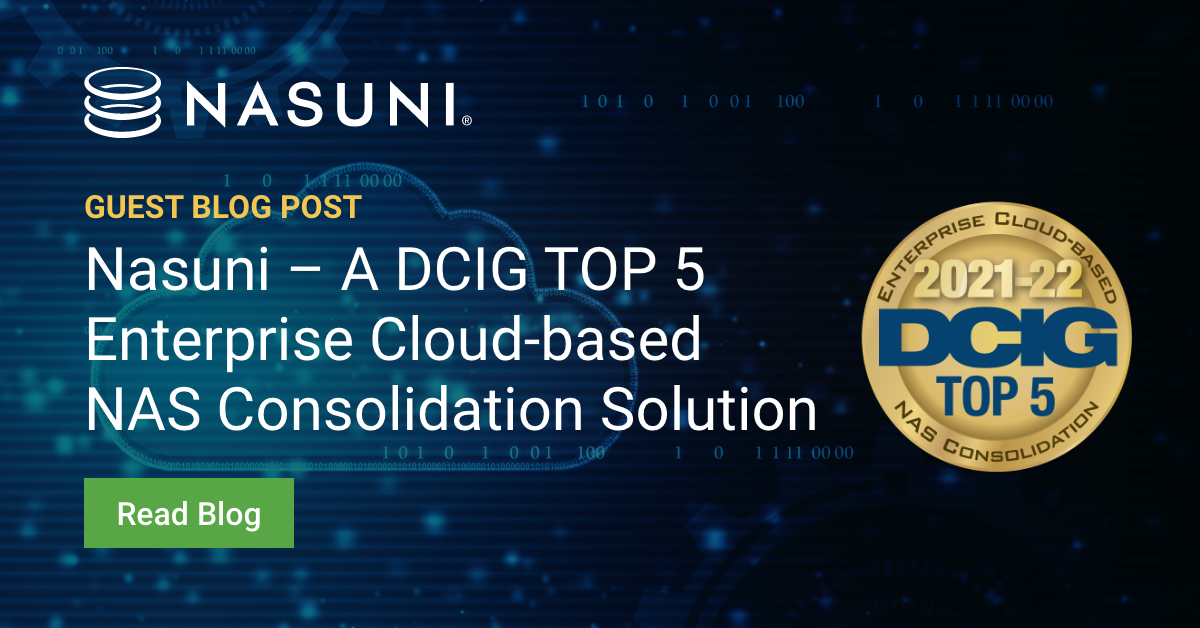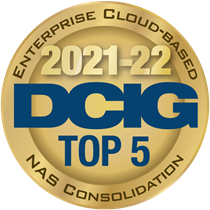Nasuni – A DCIG TOP 5 Enterprise Cloud-based NAS Consolidation Solution
Nasuni stores and synchronizes files across any number of locations at any scale. The heart of the Nasuni file services platform is its patented cloud native global file system, UniFS®.
September 21, 2021

The Expanding Volumes of Unstructured Data
Many enterprises struggle with managing expanding volumes of unstructured data throughout the organization. Storing, protecting, and securing this data creates challenges around cost, complexity, and scalability. Addressing these issues take cycles away from other important IT projects bringing innovation and future profits.
This unstructured data growth brings many difficulties.
Filled data centers
Data growth is creating demand for more storage capacity in the data center. However, floor space or power constraints may hinder expansion. Higher density storage systems may be available to these organizations, but the budget may not allow for the acquisition.
Terabytes have become petabytes
Many legacy storage systems were designed when 100 TB was a lot of data, but now many organizations need to manage multiple petabytes of data. At petabyte scale, storing, protecting, backing it up, and recovering it all is problematic using legacy solutions. Many IT departments struggle with finding or training staff with the experience to manage these environments.
If staff leave, departments may be unable to replace these individuals, placing operations at risk.
Remote office file data
Managing unstructured data at remote offices brings its own issues. Branch office locations typically lack IT staff; thus, remote offices must involve others to recover lost files. File data may fill available storage, and backup solutions may rob bandwidth during backup operations.
Consider that a one terabyte file directory can use two additional terabytes of storage for backup and offsite recovery. Further, inactive data grows as no one wants to delete files when unknowns exist. For team collaboration of files hosted at remote offices, latency can become unworkable.
Storage proliferation
Over time, a company grows and needs expanding storage. However, the current system has not reached end-of-life. So IT adds to it. Now there are two systems instead of one to manage.
Two systems become three, four, five, and ten. This growth may take place because of capacity requirements or because of protocol requirements. The effect is the same: An organization ends up with a proliferation of data silos without global visibility into the file estate of its multiple, underlying systems.
Total cost of ownership
These difficulties increase the total cost of ownership for unstructured data management. Enterprises must factor in the day-to-day expenses of ongoing maintenance and upkeep.
In addition, there are the not-so-obvious costs associated with acquiring new storage infrastructure, including cycles for budgeting, researching, evaluating, procuring, installing, and migrating data among multiple storage systems. The explosive growth of unstructured data creates costly, difficult-to-manage problems using legacy approaches to file data management.
SDS-based NAS Consolidation – Two Key Approaches
Cloud-based NAS consolidation, based on enterprise-class SDS, offers a solution for providing fast,
flexible, usable access to all of an organization’s file data for all of its end users.
There are two key approaches to NAS consolidation:
Replace. One approach replaces multiple filers with a single solution designed for multi-petabyte management. In some cases, that single solution uses object storage as the actual backing data store, whether on-premises or in the cloud.
Integrate. The other approach integrates the enterprise’s existing filers under the domain of a global file system. This enables visibility and unifies management across the data landscape. In other words, aggregating, enhancing, and overlaying the management and visibility of the file data without necessarily replacing the existing storage system.
Many SDS NAS solutions address both approaches to NAS consolidation. In addition, these products bring benefits through the following capabilities.
SDS-based NAS Consolidation Benefits
Elastic, scalable storage capabilities. Especially for solutions using public cloud providers as the back-end object store, the public cloud represents unlimited storage that can scale on demand. If new capacity is needed, an administrator can quickly turn this up.
Offloading storage infrastructure management. For public cloud storage, much of the burden of storage infrastructure management moves from the customer organization to the cloud provider. Cost management (space, power, labor), complexity (performance management, networking, administration), and capacity planning (monitoring, acquiring, implementing) shifts out of the enterprise. By offloading these activities to the cloud provider, enterprises reduce IT costs for on-premise, file data management.
Fast, remote office file sharing. Without additional aids, end-users may experience latency issues when accessing and modifying files stored in the cloud. To nullify this, many of these TOP 5 solutions use local edge appliances to cache frequently accessed files, saving changes to the cloud where the master copy is stored. This gives enterprises LAN speed access to active files wherever the office may be located, while preserving cloud benefits.
Global file system view. Rather than different data silos where IT administrators have disparate views of file storage, these solutions provide a single view of the entire file storage landscape. A single data repository replaces data silos. This global visibility also unlocks opportunities to derive new value from the data.
Global file management capabilities. Global views, including permissions management, capacity utilization, and analytics, enable new opportunities for ensuring optimal performance and cost of managing an organization’s unstructured data. Recovering corrupted or deleted files becomes simple. If a location needs access to a particular file directory, it is as easy as configuring this group’s permissions. While the dynamics causing file growth still occur, these solutions give enterprises the tools to discover and manage files globally.
Nasuni – A DCIG TOP 5 Enterprise Cloud-based Solution
DCIG ranks Nasuni as a TOP 5 solution for the cloud-based NAS consolidation use-case.
 Nasuni stores and synchronizes files across any number of locations at any scale. The heart of the Nasuni file services platform is its patented cloud native global file system, UniFS®. It unifies enterprise NAS, backup, and disaster recovery infrastructure while consolidating all of an organization’s files in cloud object storage.
Nasuni stores and synchronizes files across any number of locations at any scale. The heart of the Nasuni file services platform is its patented cloud native global file system, UniFS®. It unifies enterprise NAS, backup, and disaster recovery infrastructure while consolidating all of an organization’s files in cloud object storage.
The Nasuni solution deploys at the edge as a physical or virtual appliance on-premises or in the cloud. The Nasuni edge appliance caches frequently used files, giving office users a local file-sharing experience. Nasuni works with all major object store vendors, so organizations can choose which cloud backend to overlay with the Nasuni platform.
Three features that earned Nasuni recognition as a DCIG TOP 5 solution include:
Efficiency. With Nasuni, the ‘golden copy’ of the file resides in cloud object storage. Nasuni’s edge appliances cache frequently accessed files locally. New or updated blocks of data within any file are compressed, globally deduplicated, and encrypted before being sent to cloud object storage. This minimizes bandwidth requirements and egress fees while maximizing effective storage capacity.
Data encryption and protection. Nasuni extends protection of cloud stored data by encrypting data both in-flight and at-rest. The customer controls the encryption keys. Organizations can take advantage of the data protection inherent within cloud architecture for safeguarding data against loss. Cloud data storage can materially save enterprises the time, money, and effort associated with backups and disaster recovery plans for their unstructured data.
Fast ransomware recovery. Nasuni provides continuous file versioning to capture changes on every edge appliance as they occur. UniFS then stores file system deltas as a snapshot in object storage. Recovery points can be up to every few minutes, and recovery times just a few minutes more to restore a single file, a whole directory, or the entire file system.
See this brief Nasuni Rapid Ransomware Recovery demonstration where Nasuni recovers over a million files in less than a minute:

If an enterprise experiences a ransomware attack, it can quickly revert the affected files to a point-in-time just before the attack.
Unstructured data growth shows no signs of slowing down. NAS consolidation solutions offer enterprises tremendous value for helping enterprises manage and store their file data. Nasuni earns a well-deserved DCIG TOP 5 ranking for its solution.
This guest blog article is a product of DCIG, LLC. All other brands or products are trademarks or registered trademarks of their respective holders and should be treated as such. Product information was compiled from both publicly available and vendor-provided resources. While DCIG has attempted to verify that product information is correct and complete, feature support can change and is subject to interpretation. All features represent the opinion of DCIG. No negative inferences should be drawn against any product or vendor not included in this article. DCIG cannot be held responsible for any errors that may appear. This article was commissioned by Nasuni.